Days 3-12 – Cape Town, South Africa to Cotonou, Benin
Thursday, 17 November 2005Monday 7 November
Day 3 – Cape Town to Etosha National Park, Namibia
Our aircraft rolled out of the Convair factory in the USA back in 1953 with twin piston engines. It’s clearly been well looked after over the years and along the way the piston engines have been changed for more modern turboprops.
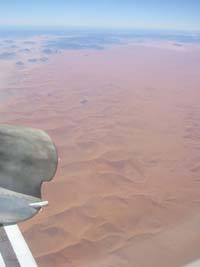 After a nice little circuit of Cape Town and Table Mountain we’re soon heading north and across the endless sand dunes of southern Namibia. Walvis Bay, our first stop, is Namibia’s major port and also has an international airport, the logistics of lining up immigration officials for our arrivals and departures is clearly one of the organisational challenges for this trip.
After a nice little circuit of Cape Town and Table Mountain we’re soon heading north and across the endless sand dunes of southern Namibia. Walvis Bay, our first stop, is Namibia’s major port and also has an international airport, the logistics of lining up immigration officials for our arrivals and departures is clearly one of the organisational challenges for this trip.
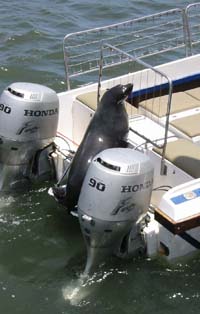 A trio of boats whisk us across the Walvis Bay lagoon to a collection of fur seal colonies, one of the seals greets us by swimming out to our boat, leaping on to the platform at the back between the outboard motors and then flopping right in to the boat, demanding a couple of fish as payment for this neat trick.
A trio of boats whisk us across the Walvis Bay lagoon to a collection of fur seal colonies, one of the seals greets us by swimming out to our boat, leaping on to the platform at the back between the outboard motors and then flopping right in to the boat, demanding a couple of fish as payment for this neat trick.
.
We also have a tame cormorant come aboard looking for a snack and later a pelican glides by in that ponderously elegant pelican flight mode, also hoping for a handout.
Lunch is in a tent set up on the beach and starts with oysters straight from an oyster farm set up just off the beach. We’ll be putting on weight if every meal is this good.
Back on the plane it’s another hour north to the huge salt pan which marks Ethosha National Park. The Mokuti Lodge, just outside the eastern boundary of the park, even has its own airstrip, just big enough to handle our elderly aircraft.
.
.
.
Tuesday 8 November
Day 4 – Etosha National Park, Namibia
I make the day’s first wildlife sighting as I swing our bedroom door open to the pre-dawn light, two giraffes are munching on the tree right outside the room. By the time we stop for a long lunch in the mid-day heat I’m beginning to realise that Etosha is giraffe central, I think I’ve seen more giraffes in one morning than I’ve seen in all my other wildlife spotting in Africa combined.
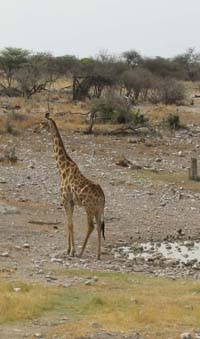 This is a prime time to visit Etosha, at the end of the dry season water is scarce so the wildlife congregates at the remaining waterholes. By sunset – it’s a long, sunrise-to-sunset day – we’ve seen a variety of antelope from kudu to Springboks and including the delicate and absurdly tiny dikdik, zebras, wildebeest, a black rhino, lots of lions (most of them basking under trees or bushes) and smaller animals including jackals and mongooses (or is that mongeese?). Of course the birders, who’ve congregated together in their own twitcher’s Land-Rover, are equally happy, since Etosha is also home to a bewildering variety of often colourfully exotic birds including an artist’s palette of hornbills that even I can recognise.
This is a prime time to visit Etosha, at the end of the dry season water is scarce so the wildlife congregates at the remaining waterholes. By sunset – it’s a long, sunrise-to-sunset day – we’ve seen a variety of antelope from kudu to Springboks and including the delicate and absurdly tiny dikdik, zebras, wildebeest, a black rhino, lots of lions (most of them basking under trees or bushes) and smaller animals including jackals and mongooses (or is that mongeese?). Of course the birders, who’ve congregated together in their own twitcher’s Land-Rover, are equally happy, since Etosha is also home to a bewildering variety of often colourfully exotic birds including an artist’s palette of hornbills that even I can recognise.
.
.
We pause at one more waterhole just as the sun sets and here the lions are more active. There’s a strong smell of death drifting out from a recently downed giraffe just off the track and a young lion emerges licking its bloody jaw but also limping badly, perhaps the giraffe didn’t give up too easily.
Today’s interesting wildlife fact: Life for a lion seems to feature lots of lazing around interspersed with occasional frenetic hunts but there’s one other energetic lion activity: sex. Ovulation is triggered by mating and lots of it, it’s been estimated that a lioness has to mate 3,000 times for a single pregnancy. No wonder they look so exhausted.
Wednesday 9 November
Day 5 – Etosha National Park, Namibia to Luanda, Angola
This morning I’ve got six giraffe congregated outside our room, one of them lowers his head from the treetop he’s been browsing to gaze at me quizzically. The alarm has gone off at 5.30 am, for the fourth morning out of five.
We’re not going to fly out of Mokuti, the airstrip length is marginal even for our Convair (which can handle fairly short runways) so it’s going to fly empty to a larger airport outside the park. At our first waterhole stop on our way out of the park, a lion stalks over just minutes after we arrive. The springboks, zebra and giraffe congregated around the hole immediately scatter a safe distance away and then stand watching the lion warily.
At the next stop there are 10 lions lounging by the waterhole. Dozens of zebra, eland, giraffe and other wildlife stand around uneasily on the other side of the hole, gazing at the water thirstily but afraid to approach. One lion gets up and make a half-hearted rush at a giraffe but there’s no energy in it, they’re quite happy to laze around. Eventually one huge eland makes it down to the hole but even then it doesn’t dare to bend its head down to the water. We leave with the impasse unresolved.
Ondangwa is just south of the Angolan border, an ex-military airstrip built by the apartheid- era South African government when they were supporting the UNITA rebels during Angola’s long civil war. It’s a reminder that Angola was a prime example of a cold war victim, when Portugal imploded in 1975 their colonies (Angola, Mozambique, Portuguese Timor, the Chinese already had de facto control of Macau) were summarily abandoned and all fell into long periods of chaos. Angola became the playground for the USSR and the USA to slug it out by way of proxies. For the Russians it was Cuban troops supporting the MPLA, for the Americans it was the South Africans supporting UNITA. Of course it was the Angolan civilians who paid the big price.
Even after the departure of the Cubans and the collapse of the Soviet Union the disaster continued because UNITA ignored a popular vote which the MPLA won fairly fair and square. Peace only returned when their leader Jonas Savimbi was killed in 2002.
Luanda is still emerging from that quarter century of darkness. During the war the population swelled from less than half a million to approaching four million and although the city is a mess it’s pretty clear that it’s a beautiful mess beneath the rags. We start with lunch at Coconuts, a beachfront restaurant where it’s easy to see that Luandan women take their beach fashion cues straight from Rio de Janiero. There are bodies and brief bikinis which would do just fine at Copacabana.
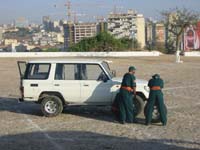 With airport delays we’re running well behind schedule, but when Jonathan Rossouw, our South African group leader and bird watcher extraordinaire, announces that we’ll skip the dessert and head straight on the Portuguese woman who is organising things in Luanda announces that everybody else may be ready to go but she’s certainly not and we can all sit and wait another 20 minutes for her.
With airport delays we’re running well behind schedule, but when Jonathan Rossouw, our South African group leader and bird watcher extraordinaire, announces that we’ll skip the dessert and head straight on the Portuguese woman who is organising things in Luanda announces that everybody else may be ready to go but she’s certainly not and we can all sit and wait another 20 minutes for her.
We’ve also got an Angolan security detail who get in the way and hold things up, especially when their 4WD has a puncture.
There’s a visit to the Fortress of San Miguel and finally to our hotel close to sunset. Our time here is so short (we fly out tomorrow) that I want to use every minute, so standing for what seems half an hour while people trudge s-l-o-w-l-y down the bus steps begins to drive me crazy and I’m ashamed to say I’m not too quiet about my impatience. I shouldn’t complain, none of them seemed to want a front row seat in the restaurant for the beach swimsuit fashion parade. I do get a quick one hour sprint around the town centre and get told off for taking a photograph of an old Portuguese street sign which turns out to be on a police station.
Thursday 10 November
Day 6 – Luanda, Angola to Loango National Park, Gabon
Gabon, Africa on a Shoestring announces, ‘can be a frustratingly slow country’ and at Port Gentil, our arrival point into Gabon, they certainly set out to prove it. Stamping 17 passports and putting some fuel in our aircraft takes over two hours. Our group splits here, half of them head off to the Central African Republic in another, smaller, aircraft. The rest of us (the 17 who had their passports slowly processed) continue to Omboue
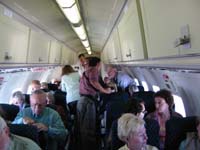 I started the day with a pre-breakfast stroll around Luanda before we head off to the airport. Luanda would be an aircraft-spotter’s delight, Russian Antonov and Tupolev airliners and lots of beat up old 727s, an assortment of giant Russian cargo aircraft (fly anything, anywhere, no questions asked), executive jets (the Swiss one no doubt organising the transfer of money to numbered bank accounts).
I started the day with a pre-breakfast stroll around Luanda before we head off to the airport. Luanda would be an aircraft-spotter’s delight, Russian Antonov and Tupolev airliners and lots of beat up old 727s, an assortment of giant Russian cargo aircraft (fly anything, anywhere, no questions asked), executive jets (the Swiss one no doubt organising the transfer of money to numbered bank accounts).
We get out to the aircraft, then go straight back to the terminal because the landing fees haven’t been paid. We’ve paid them, the Angolan ground agent just hasn’t bothered to pass the money on. That problem is soon sorted out and we head north, almost to the equator and our stop in Gabon.
At Omboue we clamber into 4WD pickups and bounce down the track for several hours to Loango Lodge on the edge of Loango National Park. Jonathan, our amazingly enthusiastic birdwatching leader, adds at least an hour to the trip by frequently drawing our small convoy to a halt to focus binoculars on a rosy-breasted lesser long-tailed google bird (male) (and in its breeding plumage) or something similar which it takes an enthusiastic birder to properly appreciate. We’re all becoming enthusiastic birders.
Friday 11 November
Day 7 – Loango National Park, Gabon
I never realised gorillas could laugh – or chuckle and giggle. Gorillas are what today is all about. We split the group again and eight of us head of by track and then river to Evengue Island where the Loango Lodge is rehabilitating lowland gorillas.
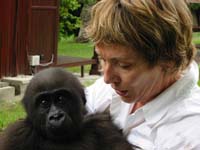 Gorillas are often killed to be eaten as ‘bushmeat’ or because they’ve been raiding crops or vegetables. The Evengue Island rescues baby gorillas orphaned by these killings and tries to raise them to live independently. At the island we meet three recently rescued gorillas not yet old enough to join the other gorillas on the island.
Gorillas are often killed to be eaten as ‘bushmeat’ or because they’ve been raiding crops or vegetables. The Evengue Island rescues baby gorillas orphaned by these killings and tries to raise them to live independently. At the island we meet three recently rescued gorillas not yet old enough to join the other gorillas on the island.
One of them takes a shine to Maureen and snuggles in comfortably in her arms. Later we walk in the forest with two of their handlers who are trying to show the young gorillas how to climb trees and gather food, both skills they seem to be picking up rapidly.
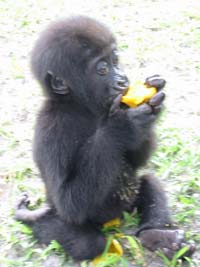 They’re clearly fun loving animals and when one of the handlers tickles Cindy-la (male, despite the name), at 18 months the oldest of the trio, he lies on his back laughing with open mouth delight. He clearly does not want the game to stop.
They’re clearly fun loving animals and when one of the handlers tickles Cindy-la (male, despite the name), at 18 months the oldest of the trio, he lies on his back laughing with open mouth delight. He clearly does not want the game to stop.
Unfortunately these gorillas are probably never going to go back to the jungle, the island is going to be home.
.
.
.
.
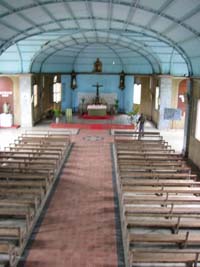 On the way to Evengue we paused at St Anne Mission which has a church, dating from 1887 said to have been built (or designed?) by Gustave Eiffel. It’s certainly an all metal construction. Over the year’s I’ve also encountered an Eiffel cathedral (in the Caribbean) and an Eiffel railway station (in South America), quite apart from that well known tower.
On the way to Evengue we paused at St Anne Mission which has a church, dating from 1887 said to have been built (or designed?) by Gustave Eiffel. It’s certainly an all metal construction. Over the year’s I’ve also encountered an Eiffel cathedral (in the Caribbean) and an Eiffel railway station (in South America), quite apart from that well known tower.
.
.
.
.
Saturday 12 November
Day 8 – Loango National Park, Gabon
Sometimes the wildlife simply does not co-operate. Even when it does, mid-afternoon as we’re kayaking down the lagoon behind the beach, the group of elephants which set out to wade across the lagoon are a half km behind us, back where we were half an hour ago. We turn round to gaze at them but by the time we could kayak back they would have been long gone.
We’d started the day by crossing the river into the national park and driving to a gorilla and chimpanzee habituation project. The three young women (two British, one German) running the project are out in the forest working on ‘habituating’ the primates, getting them used to human contact so, one day, they won’t get spooked by tourist groups turning up. This is going reasonably well with the chimpanzees, not at all well with the gorillas. The forest cover is so thin that they need huge territories and, if disturbed, can disappear instantaneously.
After our lagoon kayak trip the wildlife finally does co-operate during the drive back to the lodge, there are a couple more elephant sightings.
Sunday 13 November
Day 9 – Loanga National Park, Gabon to Dzanga-Sangha National Park, Central Africa Republic
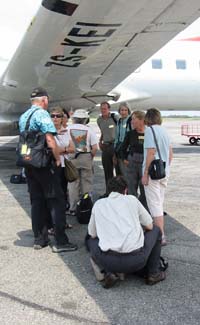 Having driven back to Omboue and flown back to Port Gentil we swap aircraft with the CAR group and fly first to Yaounde in Cameroon to refuel the Dash 8. There’s no fuel available at Bayanga, our CAR destination, so we have to make this intermediate stop in order to carry enough for the return trip. From Yaounde the view below is continuous jungle, all the way to Bayanga right in the extreme south-west corner of CAR.
Having driven back to Omboue and flown back to Port Gentil we swap aircraft with the CAR group and fly first to Yaounde in Cameroon to refuel the Dash 8. There’s no fuel available at Bayanga, our CAR destination, so we have to make this intermediate stop in order to carry enough for the return trip. From Yaounde the view below is continuous jungle, all the way to Bayanga right in the extreme south-west corner of CAR.
Half the village seems to have turned out to greet us when we land on a very primitive looking grass airstrip. Aircraft only turn up about once a month so having two flights in a week, and the Dash 8 sitting there all week, is quite an event.
.
The logistics of this trip are amazing, the 4WDs we’ll be getting around in have been driven here from the coast of Cameroon, 1500km away. After they’d crossed the border into CAR they’d had to negotiate their way through 27 police checkpoints along the road to Bayanga. We’ve also brought in most of our supplies and Vivienne and Carol, part of the crew from South Africa who organise all this, will run the kitchen at the riverside lodge. The last group here was in August.
Monday 14 November
Day 10 – Dzanga-Sangha National Park, Central Africa Republic
Makumba could easily go 10 rounds with King Kong I reckon.
Lowland gorillas are smaller than the mountain variety more regularly encountered by visitors to East Africa, but when Makumba, the silverback leader of a troop of 13 lowland gorillas, sits impassiv
ely, just across a small clearing from our group, he looks quite big enough.
‘We’re walking though the jungle in the Congo River basin, following a pygmy tracker, looking for gorillas,’ Maureen recalled later that day. ‘How good is that?’
Only a handful of our group would get to track gorillas, they only allow two or three visitors a day, but Maureen and I got two of the spots and at 5.45 depart in one of the world’s most beat up Land Rovers. It wasn’t that old and it may not have driven to the moon and back but it clearly had been to hell and back. The 28km (1-1/2 hour) trip to the Bai Hokou gorilla camp was definitely en route. We bounced through waterfilled potholes, angled off deep ridges and for most of the distance virtually pushed through the encroaching jungle, occasionally snagging vines and trailing them behind us.
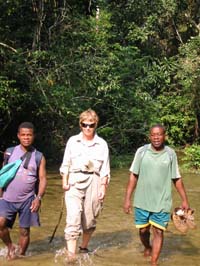 From the camp it was a couple of hours walk to where the gorilla trackers had traced the troop and settled down to observe them. Our first sighting was of four gorillas perched high up in what looked like far too small a tree. Occasionally they’d nonchalantly swing out to what looked like much too flimsy a branch to support a hulking primate’s weight.
From the camp it was a couple of hours walk to where the gorilla trackers had traced the troop and settled down to observe them. Our first sighting was of four gorillas perched high up in what looked like far too small a tree. Occasionally they’d nonchalantly swing out to what looked like much too flimsy a branch to support a hulking primate’s weight.
Descending from the tree they then sat at ground level, observing us while we observed them. They moved off and we followed, leading to our encounter with the troop’s leader, the impressive silverback Makumba. There are more sightings in the forest before we move back to the camp and then set out again to visit with a troop of mangabey monkeys.
Tuesday 15 November
Day 11 – Dzanga-Sangha National Park, Central Africa Republic
There are not enough tourists to keep the Ba’Aka happy.
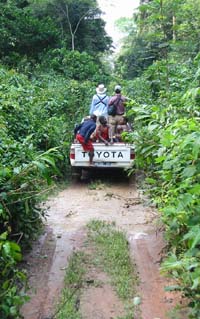 We drive out of Bangay to a series of Ba’Aka, the local pygmy group, villages to collect a group to go hunting and there are far more would-be-hunters than we can accommodate. I ride in the back of one of the pickups with a bunch of the hunters and Louis, an American who came to the area 20 years ago to study the music and stayed. It’s a very noisy ride into the jungle, songs ricocheting back and forth between the pickups.
We drive out of Bangay to a series of Ba’Aka, the local pygmy group, villages to collect a group to go hunting and there are far more would-be-hunters than we can accommodate. I ride in the back of one of the pickups with a bunch of the hunters and Louis, an American who came to the area 20 years ago to study the music and stayed. It’s a very noisy ride into the jungle, songs ricocheting back and forth between the pickups.
‘They’re belittling the men’s genitals,’ translates Louis as the women in our truck belt out a hunting song.
‘And they’re replying in kind,’ he continues as another chorus sails back from the truck ahead.
At our hunting spot the Ba’Aka string out their hunting nets within minutes. A series of 20-metre long nets ring an area where they think there will be an animal and then the pygmies shout and yell to drive their prey into the net.
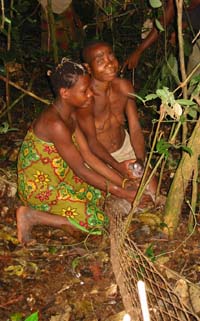 Yesterday’s hunt was unsuccessful but today the ‘woo-ah’ announcing a blue duiker sighting rings out almost immediately. A rising chorus of ‘woo-ahs’ peaks as the tiny antelope is entangled in a net and despatched with a whack to the head. The nets are quickly moved to another location and a second blue duiker is caught with equal speed but a third one escapes and that’s it for the morning, nothing else turns up.
Yesterday’s hunt was unsuccessful but today the ‘woo-ah’ announcing a blue duiker sighting rings out almost immediately. A rising chorus of ‘woo-ahs’ peaks as the tiny antelope is entangled in a net and despatched with a whack to the head. The nets are quickly moved to another location and a second blue duiker is caught with equal speed but a third one escapes and that’s it for the morning, nothing else turns up.
In the afternoon we drive to Bai Dzanga , an hour’s drive and a half hour’s walk. Bai Dzanga is a clearing in the jungle with waterholes and mineral deposits, which elephants love. So there are more than 50 elephants here, doing all the usual elephant things.
From an observation stand to one side of the clearing they’re watched over by Andrea, an elephant observer who has been keeping watch over this herd for 15 years.
They’re doing all the interactions which quickly convince you that elephants are far more than big grey creatures. A very small baby elephant is frightened by a bull trumpeting and immediately its mother is standing beside it, draping a comforting trunk over the baby. Two adolescents get into some sort of dispute and older elephants come over to sort things out and offer advice. A big bull marches over to the prime mineral deposit and other elephants quickly vacate the depression, deferring to the boss pachyderm.
It’s dusk to dark by the time we get home, but the day’s three gorilla visitors are still not back, when they do return it’s a sorry story. They’ve spent the whole day tracking the gorillas without ever getting a sight. We made yesterday seem so simple and straightforward we feel enormously guilty, but hey, this is not Disneyland, sometimes disappointments make the successes even more amazing.
Wednesday 16 November
Day 12 – Dzanga-Sangha National Park, Central Africa Republic to Cotonou, Benin
There’s only a small crowd at the airstrip to see us off. A couple of young guys practise walking up the steps waving to their friends to be photographed as if they’re heading off somewhere.
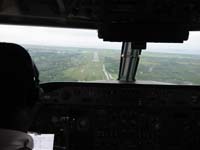 In Yaounde in Cameroon, our refuelling stop on the way back to Gabon we’re stalled. The ground agent hasn’t turned up at the airport to pay for the fuel! We end up waiting for nearly two hours. As on our previous stop we just stand around on the tarmac; the airport is remarkably quiet, after one flight leaves we are the only plane there.
In Yaounde in Cameroon, our refuelling stop on the way back to Gabon we’re stalled. The ground agent hasn’t turned up at the airport to pay for the fuel! We end up waiting for nearly two hours. As on our previous stop we just stand around on the tarmac; the airport is remarkably quiet, after one flight leaves we are the only plane there.
Eventually we’re ushered through immigration to the airport restaurant, but just at this point a man in the terminal hurls his sunglasses on the ground and steps on them, throws his mobile phone down as well, tips everything out of his pockets and then proceeds to take all his clothes off and march down the terminal complaining about something. Dropping his underpants finally convinces the cops standing around to grab him and march him off.
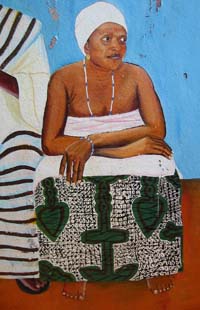 Fuel paid for we finally depart, fly back to Gabon, U-turn and fly off to Benin, our fourth country for the day. Zipping through immigration and customs we jump into a bus and race down the coast to Ouidah, site for Bruce Chatwin’s The Viceroy of Ouidah. We’ve lost so much time waiting for a wing-full of fuel our visit is cut short but we do still manage to squeeze in a voodoo dance performance before we drive back to Cotonou and our featureless Novotel.
Fuel paid for we finally depart, fly back to Gabon, U-turn and fly off to Benin, our fourth country for the day. Zipping through immigration and customs we jump into a bus and race down the coast to Ouidah, site for Bruce Chatwin’s The Viceroy of Ouidah. We’ve lost so much time waiting for a wing-full of fuel our visit is cut short but we do still manage to squeeze in a voodoo dance performance before we drive back to Cotonou and our featureless Novotel.






